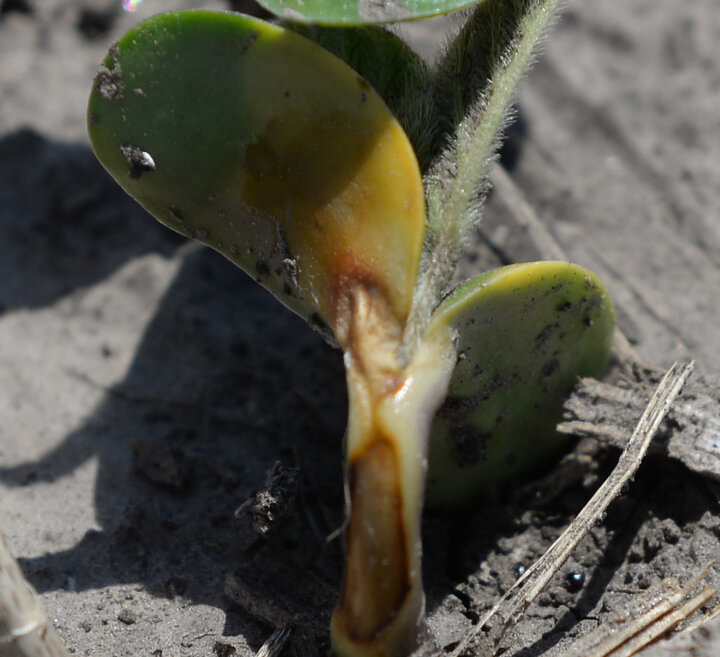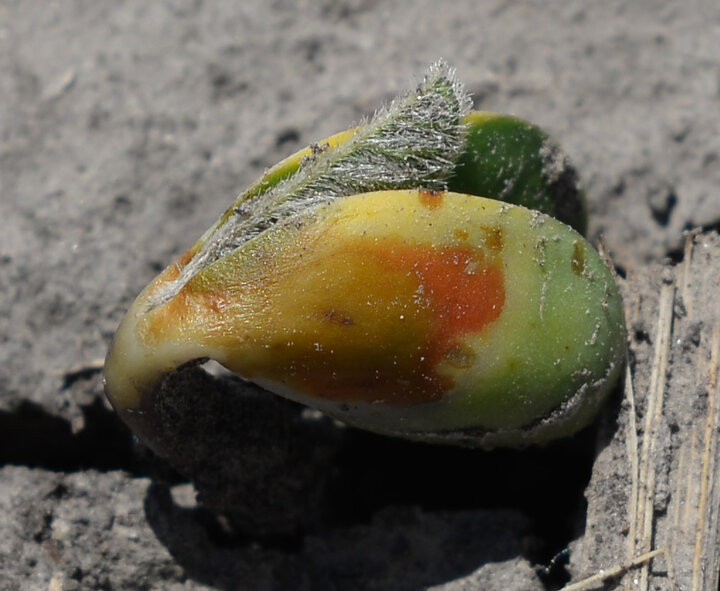Residual herbicides applied after planting but before soybean emergence are important weed management tools for early season weed control. Protoporphyrinogen oxidase (PPO) inhibiting herbicides (Group 14, herbicide mode of action classification), applied alone or in pre-mix or tank-mix with other herbicides are widely applied for residual weed control in soybean. Once applied, several factors can affect weed control efficacy and crop safety.
Injury from residual application of PPO inhibitors is not common and can be confused with symptoms of soybean seedling disease. When PPO-inhibitor injury does occur, the severity of soybean injury is largely determined by environmental factors. Cool, wet soil conditions, such as we experienced this year after planting, can enhance soybean injury from soil-applied herbicides. Soybean plants growing under favorable conditions can adequately metabolize PPO-inhibiting herbicides before injury symptoms are expressed; however, when soybean plants are under stress, their ability to metabolize herbicide can be reduced to a point where injury symptoms develop.
For the last couple of weeks, I have received numerous phone calls/reports regarding soybean seedling injuries. In the majority of these fields, the cotyledons are reddish/brown as is the hypocotyl, especially when in the neck stage (Figure 1). This appears to be happening to all cultivars from all companies and is not seed specific.
Most fields with injury have been sprayed with flumioxazin-based herbicides (Envive, Enlight, Fierce, Fierce XLT, Rowel, Rowel FX, Trivence, Valor, and Valor XLT). A few fields were also sprayed with other commonly used PPO-inhibitor herbicides containing sulfentrazone (Authority brand herbicides, Spartan, Sonic) or saflufenacil (Sharpen, OpTill). They have shown the same symptoms.
The herbicide label of most PPO inhibitors states:
- Application should be made within three days of planting soybean.
- Crop injury may occur from applications made to poorly drained soils under cool, wet conditions.
- Risk of crop injury can be minimized by not applying this herbicide on poorly drained soils, planting at least 1.5 inches deep, and completely covering seeds with soil prior to pre-emergence applications.
- If flumioxazin-based herbicide is applied after soybeans have begun to crack, or are emerged, this will result in severe crop injury.
Several areas with soybean seedling injuries from PPO inhibitors received over 4 inches of rain in late May. This would constitute “poorly drained soil.”


The Bottom Line
- When scouting for potential herbicide damage, open up the cotyledons to see if they are green. If the necks are firm and the inside of the cotyledons are green, it is likely the seedling will survive.
- Figure 2 shows a brown neck that is still firm with green cotyledons; this plant will probably survive.
- Stand count of soybean plants will be useful to determine plant population and replant decision. If your plant population is about 80,000 evenly spaced plants per acre in 30-inch rows, yield should not be affected. This is typical in most of the soybean fields I have visited.
- Warm temperatures and little or no precipitation the last 10 days will help soybean seedlings grow and recover from this injury.
Remember that PPO-inhibiting herbicides do not cause injury every year. They have a risk, as do all herbicides, depending on weather. PPO-inhibiting herbicides provide great residual activity against many tough-to-control weeds and can be valuable tools in the battle against common waterhemp, Palmer amaranth, and common lambsquarters.

